Bowie knives have been the rage on the American frontier, ever since the 1830s.
Today’s Bowies are better than ever and the traditional, proven design, combined with old-time craftsmanship and modern materials creates a new classic.
by Leon Pantenburg
Disclaimer: Knivesshipfree.com and DLT Trading LLC are Survivalcommonsense.com affiliates. I did not get a free knife, and nobody had any input in this review. All I ever promise is a fair review, and this is my opinion.
A historically-accurate knife, that is a proven user and made with modern materials, hits me squarely in the wallet.
This was on my cutlery bucket list: I want to try out an authentic Bowie. Then Bark River came out with the Edwin Forrest Bowie. I saw the photo of the knife, instantly recognized it, and sent my order in.
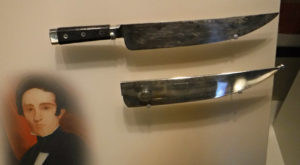
This original Bowie is on display at the Museum of Mississippi History. The blade has the inscription: “Presented to Jesse Perkins by R.P. Bowie 1831.”
Last year, I was at the opening of the Mississippi Civil Rights Museum in Jackson, and I went to the adjacent Museum of Mississippi History. Gravitating, as usual, to the displays of frontier relics, I found an original Bowie, made by Rezin P. Bowie, on display. (I’m that guy who will get down on his knees next to a display case to study something minutely.)
On close inspection, I noticed the Rezin Bowie knife closely resembles the 12-inch breaking knife Eric Addy, the butcher who owns and operates Addy Custom Meats, uses as his main tool. (I spent an afternoon in the shop testing knives, and was impressed how quickly and efficiently Eric and his wife Teheala worked.)
And that original Rezin Bowie design makes sense. In the early 1800s, most knives were handmade by blacksmiths, and every blade was custom made to the customer’s specifications and needs. Cattle and butchering were among the other business dealings the Bowie brothers were involved in.
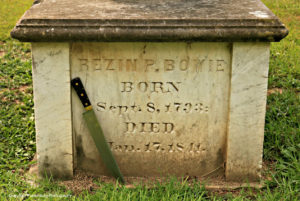
The Forrest Bowie was photographed at the grave of Rezin P. Bowie, inventor of the Bowie knife.
So, here is a quick history lesson about why this knife became so famous worldwide. The Bowie knife design goes back to the celebrated Sandbar Fight on Sept. 19, 1827, near Natchez, Mississippi.
According to the Texas State Historical Association:
“On that date Samuel Levi Wells and Dr. Thomas Maddox engaged in a duel on the first large sandbar above Natchez on the Mississippi state side of the river. After firing pistols at each other without effect, Wells and Maddox shook hands and started off the field.
“But members of the Maddox group suddenly fired at Wells’s followers, who included James Bowie. Bowie fell, shot through a lung. An archenemy, Norris Wright, along with Alfred Blanchard, stabbed him repeatedly with swordcanes. In a final effort Bowie raised himself, grabbed Wright, and sank the big knife into his assailant’s heart, killing him instantly.” (Read the complete Texas State Historical Association account.)
Back to the present.
Bark River Knives: Edwin Forrest Bowie
Specifications courtesy of Knivesshipfree.com
| Overall Length: | 17″ |
| Blade Length: | 12.25″ |
| Blade Height: | 1.775″ |
| Blade Steel: | A2 Tool Steel |
| Blade Hardness: | 60HRC |
| Blade Thickness: | .187″ |
| Weight: | 18.6oz. |
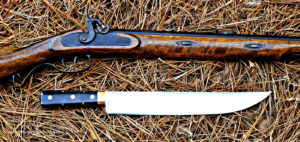
The Forrest Bowie and Lyman Great Plains Rifle will warm the heart of any mountain man history nerd.
Here’s the good stuff.
Steel: The Bowie is made of A2 steel hardened to 60 HRC, one of my favorites. A knife like this Bowie needs some patina to look authentic, and over time, the A2 steel will age nicely. A2 also holds an edge really well.
A2 is a tool steel, and this Bowie is a solid tool.
Handle: The museum Bowie has a black handle that looks to me like ebony. My Forrest Bowie has a black micarta handle. There are a couple reasons I chose black micarta: First and foremost, it looks like the museum Bowie. And it matches most of my kitchen knives, and my wife will likely lay claim to it.
Also, my experience with micarta handles is that they tend to get almost tacky when wet. This is an asset on a knife that will be used for butchering.
For a knife that will get hard use, I’ll take an A2 steel blade with a micarta handle.
Handling: I had to change my thinking on Bowie knives. Most of the ones I’ve handled were designed to be safe queens and not used. They felt bulky and awkward.
There is no question you’re handling a large knife, but the Forrest Bowie feels nimble in the hand. It is blade heavy, as expected, but it doesn’t feel cumbersome.
Grind: All blades used to be convex ground, and I presume the museum Bowie has a convex grind.
When it comes to a working knife, convex works the best for me. I’ve tested different grinds in the field, and in side-by-side comparisons, convex came out as number one. This Forrest Bowie, unlike the hollow handle Rambo monstrosities, is designed to be an actual working knife. Like the originals, the knife could be used for self defense, but was first and foremost designed to be carried as a tool. The Forrest Bowie is one of the first such knives I’ve come across that goes back to the original Bowie knife roots.
Point: The trailing point is a good choice for a knife that will be used for cutting meat and quartering large animals. This also makes it a good slicer. I’m already contemplating using the Bowie to carve a turkey.
Blade thickness: At .187 inches thick, this is another authentic aspect. Obviously, I couldn’t take the original out of the display case to measure it, but the Rezin Bowie’s blade appeared to be about that thick.
This reinforces my prejudice against thick blades. If the custom Rezin Bowie knife, designed to be a fighter and a butcher implement, has a relatively thin blade, why do we need thick blades in modern knives? The Forrest blade thickness makes the knife one hell of a melon slicer, and it works well on meat, too.
Hilt: The inset (or whatever that cutout is called) between the bolster and heel is another authentic touch. You’ve seen this cutout on chef knives. Photos I’ve seen of the original 1700s long knives used on the American frontier show this was a very common design.
It’s also a common sense choice. A micarta handle won’t be slippery, and it would be next to impossible for your hand to slip down the handle and onto the blade. I presume this Bowie would most likely be used in a hammer grip.
Sheath: Made of sturdy leather, the sheath protects the edge and the user. It is reasonably comfortable to wear on a belt, but my Bowie will be carried in my daypack.
Warranty: Unconditional satisfaction is guaranteed. The Bark River company stands behind their blades.
Made in USA: All Bark River knives are made in Escanoba, Michigan, by skilled American craftspeople. These workers make a decent living wage, pay local, state and federal taxes, and are assets to their community. Call the factory and you can talk directly to the person who made, shipped or designed your Bark River.
So do you need a Edwin Forrest Bowie?
The answer is probably, why not?
It looks really cool, and it has Bark River quality, and it is definitely a user knife. For history nerds like me, an authentic user Bowie fits right in with my old time firearms, and hunting methods.
I haven’t had a chance to do much with the Bowie except cut some brush, whittle some wood, and slice meat and watermelons. But alligator season opens in the middle of August here in Mississippi, and my next door neighbor drew tags. Assuming they are successful in their hunt, I may be helping skin an alligator (Another item on my bucket list.)
Anyway, generations of backwoodsmen, frontiersmen, explorers, adventurers etc. have decided this Forrest Bowie design makes the best survival knife and chose this configuration. I can’t wait to wring this knife out. I’ll let you know how it comes out.
Please click here to check out and subscribe to the SurvivalCommonSense.com YouTube channel – thanks!
Please click here to check out and subscribe to the SurvivalCommonSense.com YouTube channel – thanks!

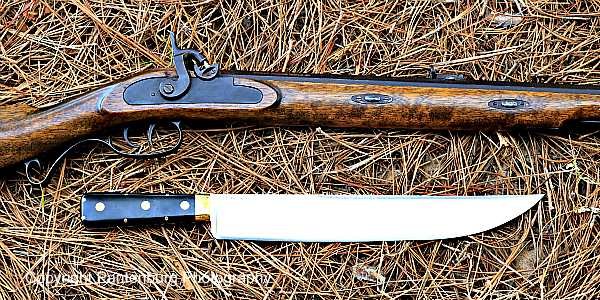

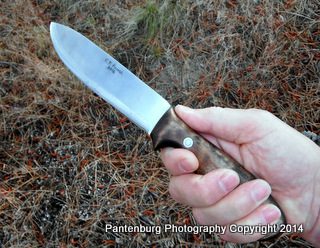
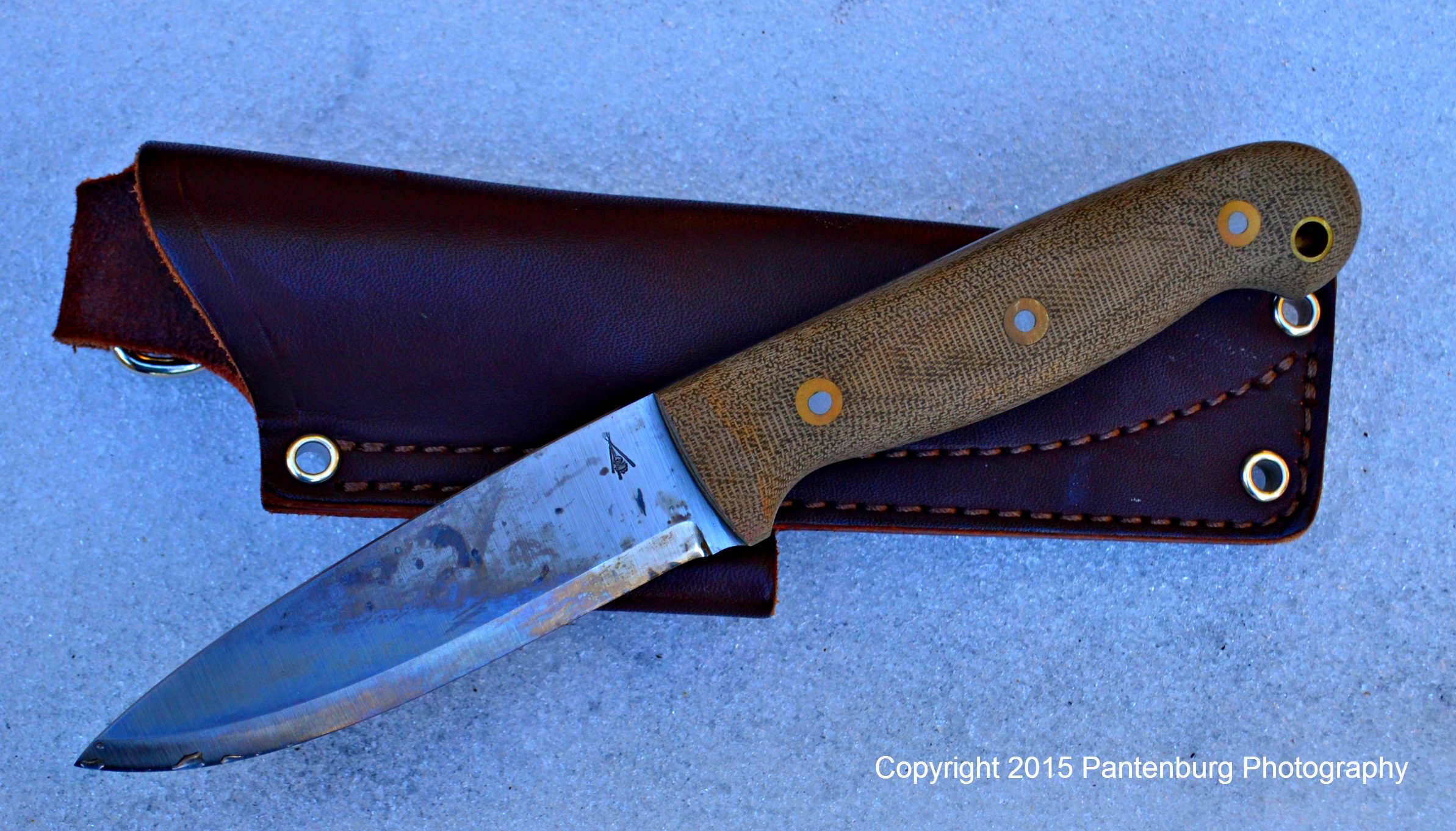
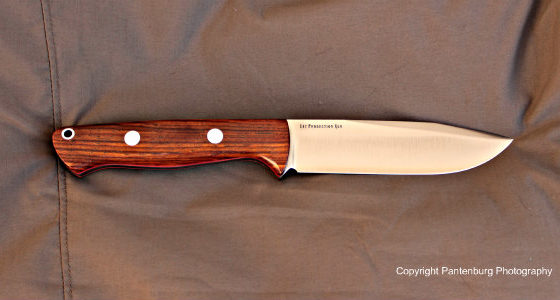
Leave a Reply